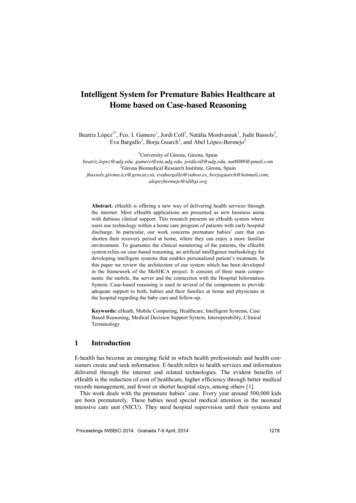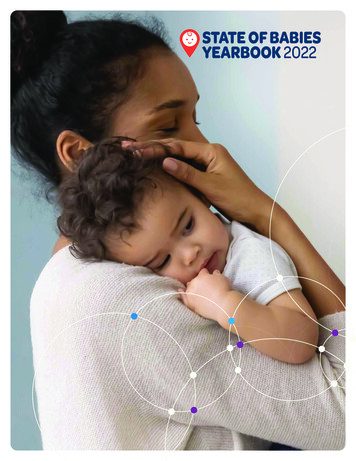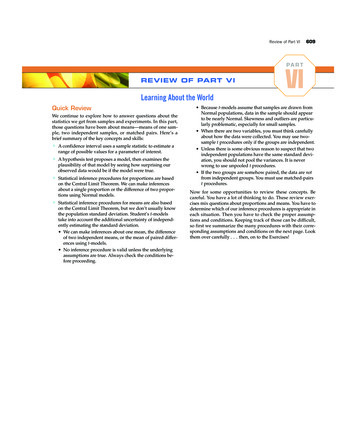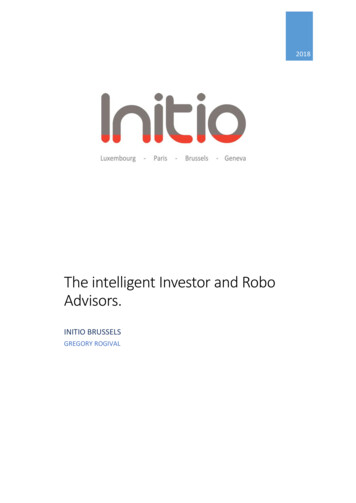
Transcription
Intelligent System for Premature Babies Healthcare atHome based on Case-based ReasoningBeatriz López1*, Fco. I. Gamero1, Jordi Coll1, Natàlia Mordvaniuk1, Judit Bassols2,Eva Bargallo2, Borja Guarch2, and Abel López-Bermejo21University of Girona, Girona, Spainbeatriz.lopez@udg.edu, gamero@eia.udg.edu, jordicoll@udg.edu, nat6086@gmail.com2Girona Biomedical Research Institute, Girona, Spainjbassols.girona.ics@gencat.cat, evabargallo@yahoo.es, stract. eHealth is offering a new way of delivering health services throughthe internet. Most eHealth applications are presented as new business arenawith dubious clinical support. This research presents an eHealth system whereusers use technology within a home care program of patients with early hospitaldischarge. In particular, our work concerns premature babies’ care that canshorten their recovery period at home, where they can enjoy a more familiarenvironment. To guarantee the clinical monitoring of the patients, the eHealthsystem relies on case-based reasoning, an artificial intelligence methodology fordeveloping intelligent systems that enables personalized patient’s treatment. Inthis paper we review the architecture of our system which has been developedin the framework of the MoSHCA project. It consists of three main components: the mobile, the server and the connection with the Hospital InformationSystem. Case-based reasoning is used in several of the components to provideadequate support to both, babies and their families at home and physicians atthe hospital regarding the baby care and follow-up.Keywords: eHeath, Mobile Computing, Healthcare, Intelligent Systems, CaseBased Reasoning, Medical Decision Support System, Interoperability, ClinicalTerminology1IntroductionE-health has become an emerging field in which health professionals and health consumers create and seek information. E-health refers to health services and informationdelivered through the internet and related technologies. The evident benefits ofeHealth is the reduction of cost of healthcare, higher efficiency through better medicalrecords management, and fewer or shorter hospital stays, among others [1].This work deals with the premature babies’ case. Every year around 500,000 kidsare born prematurely. These babies need special medical attention in the neonatalintensive care unit (NICU). They need hospital supervision until their systems andProceedings IWBBIO 2014. Granada 7-9 April, 20141278
organs can function with no external assistance. Recent studies show that during partof this time the baby needs only supervision rather than medical treatment and thatthis time is shorter if spent in a familiar and loving environment. However,complications might arise at any time and the vital signs of the baby should be closelymonitored. To monitor babies at home, mobile devices offer an invaluable service.This work is related to developing an application for home care of premature babiesthanks to mobile devices. The work is framed in the MoSHCA project.MoSHCA [2] is a mHealth project designed to improve the patient-doctorinteraction and control of diseases. The number of people with chronic or longtreatment diseases is growing worldwide. Self-management of such diseases is crucialin the prevention of serious and costly complications. MoSHCA provides intelligent,user-friendly, secure, medical and well-being decision-making embedded software,utilizing medical sensors that synchronize with the mobile phone, and this in turn withmedical information systems. MoSHCA enables the home care of several patients thatotherwise should extend their hospital stay. The authors of this paper are two of thepartners of the MoSHCA project (IdIBGI and the eXiT research group of theUniversity of Girona) which focus on the case use of the system for home care ofpremature babies.The aim of this paper is to present the architecture of the intelligent systemdeveloped for the premature babies’ application, with special use of case-basedreasoning (CBR) which enables a personalized care of babies. Our goal is to providean application to premature babies’ cares with an intelligent reasoning module thatprovides recommendations and supports them in the baby care, while keeping themunder the control of clinical staff.The paper is organized as follows: next section provides a brief overview of therelated work. Section 3 describes the use case which motivates the proposedintelligent system. Section 4 outlines Case-Base reasoning as the underlying methodof our intelligent system. Next, the architecture designed and the differentcomponents are described in Section 5. Finally, the last section provides concludingremarks and directions for further research.2Related workCBR has already been applied in a number of different applications in medicine [3,4]. CBR is appropriate in medicine for some important reasons; cognitive adequateness, explicit experience, duality of objective and subjective knowledge, automaticacquisition of subjective knowledge, and system integration [5].Currently there are some cases of applications for mobile using CBR, but mainlyon tourism applications. In the healthcare domain, CBR on mobile applications hasalso been used in the field of smoking cessation [6]. The authors state that mobilebased messaging systems have already experienced acceptability when backed by themotivation to undertake certain behavior changes, according to the results of severalexperiments. CBR enables in this case, the personalization of messages. Other healthapplications on mobile phone lacks of intelligent components, as we are developing.There are some applications available off-the-shelf [7, 8], most of them designed tocollect information at home that is processed later on by physicians. The monitoringProceedings IWBBIO 2014. Granada 7-9 April, 20141279
that they are currently performing consists on filtering out the information entered bythe cares manually, and locally, at the mobile device, they perform a simple filteringof the values entered according to some given allowed ranges. In [9] a physiologicalmonitoring application for Android mobile devices is presented. The application hasbeen designed for connecting to any Bluetooth health device and it enables datatransfer to a remote server.From our understanding, mobile devices has much more capacity, and are currentlyable to host most sophisticated applications. Particularly, we focus on includingArtificial Intelligence based decision support techniques to make mobile applicationssmart.3The premature babies’ use caseUsually, preterm infants are discharged when they achieved a certain weight, typicallyaround 2200g. However, there are some babies that only need supervision rather thanmedical treatment while they achieve this weight. Then, when a baby is suitable forminimal medical care, parents can measure the vitals of their infant comfortably athome and submit the results to be efficiently reviewed by the doctor. In that doing,three functionalities are analyzed under the case-based reasoning approach: monitoring, reasoning and alerting. Such functionalities are understood as follows: Monitor functionality: raw data health indicators of the patient are obtained andstored in an internal storage. Table 1 shows the variables consider in this use case.Sensors used include baby pulse-oxymeter and a baby scale, which provide the information in a wireless basis, a skin thermometer and a transcutaneous bilirubinometer. None of these devices is considered invasive for the baby. A context provider may gather some quality parameters (i.e. timestamp, precision, accuracy) thatwill be used for evaluating the quality of sensed information. Thus, errors on dataacquisition and processing are taken into account. Reasoning functionality: an intelligent system analyses the features (health indicators) obtained by monitoring and concludes three different types of situationswhich are passed to the alerting module: Assessment 1: Baby recovers normally: The intelligent system does not showany alert (everything is fine with the baby). Assessment 2: Baby recovers abnormally: The baby’s parameters are out of ordinary. Assessment 3: Baby recovers abnormally and an emergency actuation is required. The baby’s parameters are extremely out of ordinary. Alerting functionality: alerts are raised whenever critical states (assessments 2 and3) are detected based on the data processed by either the monitor or the reasoningfunctionality, or when an improper operation in any part of the system is identified(i.e. a sensor malfunction or server crash). Also, if no critical alert was triggered,the parents receive an acknowledgment from the doctor to assure the correct evolution of the baby. Alert 1: malfunction of an element in the system.Proceedings IWBBIO 2014. Granada 7-9 April, 20141280
Table 1. Input variables. There are three types of variables according to whether they havebeen assisted by the mobile (M), a sensor (S) or provided by caregivers (C).ParameterDate and hourGeneral aspectWeightHeart rateRespiratory rateHemoglobin saturationAxillary temperatureBilirubinFeedings a dayDaily stoolsWeekly stoolsSleepingTaking vitaminsTaking ironTaking medicationOther aspectsDescriptionDate and time of day when the baby is assessed.Normal colour and breathing normally.Weight of undressed infant in gr.Heart beats per minute.Respirations per minute.Percentage of oxygen saturated haemoglobin.Skin temperature taken in the axilla in Celsius degrees.Concentration of total bilirubinNumber of feeds per day.YES, or NO, depending on whether the baby passesdaily stools or not.Number of stools in a week, in case they are notpassed on a daily basis.Whenever the baby sleep mostly during the day, atnight, or at any time during the day and night.Whether the baby receives vitamins or not.Whether the baby receives iron supplements or not.Whether the baby receives other medications or not.Hygiene, ambient temperature, intercurrent illnesses.AssistedMCSSCSSSCCCCCCCC Alert 2: Baby recovers abnormally: The baby’s parameters are out of ordinary.A warning notifies this situation to the parents through the smartphone. The parents contact the hospital and get new instructions. Doctor requests a data updateand examines the data. Alert 3: Baby recovers abnormally and an emergency actuation is required. Anemergency alarm is shown to both, the parents and doctors smartphone. Parentsshould take the baby to hospital. Doctor requests a data update and examines thedata. Ack: The doctor has examined the data and everything is fine with the baby.4CBRCBR is a methodology for developing knowledge-based systems that attempts tosolve a given problem within a specific domain by adapting established solutions tosimilar problems [10, 11].CBR has been formalized for purposes of reasoning and learning based on the exploitation of existing similar historical records as humans do. It has been argued thatCBR is not only a powerful method for computer reasoning, but also a pervasive behaviour in every day human problem-solving; or, more radically, that all reasoning isProceedings IWBBIO 2014. Granada 7-9 April, 20141281
Fig. 1. Four-step process (4R) of Case-Based Reasoning (based on [10])based on past cases personally experienced. These features make CBR a good contender for any decision support system [12].The CBR process is divided in four main steps known as the four Rs: retrieve,reuse, revise and retain (Figure1). It basically consists in retaining experiences ascases for a further reuse. Cases are registers containing a description of a problem andits solution. The input of the cycle is a new case of a problem to be solved, and a casebase with instances of problems that have already been solved. First of all, the mostsimilar cases are retrieved of the case base. Then, the solution of these past cases isreused to solve the new case. Reuse implies an adaptation procedure of the retrievedsolutions that is finished with a revision. After validation, the cycle is completed byretaining the solved situation (problem new solution) in the case base for futureusages.A key factor in constructing a good CBR engine is defining a model containing thevariables needed to decide which decision of a set should be taken. In this proposalthe set described above (Table 1) have been used. Then, a case consists in two parts:the baby measurements listed in (Table 1), and the solution or baby state assessment.5Intelligent system for e-HealthThis section describes the architecture and the components of the medical systemdesigned for the premature baby care use case. The general scheme (Figure 2) is composed by three main components: a mobile capable of gathering data from sensors, anexternal server, and the Hospital Information System (HIS). It is based on the generalframework agreed in the Moshca consortium and can be consulted in [13]. Propersensors are attached to the baby to start monitoring according to hospital protocol.Most of these medical parameters can be automatically read by a smartphone viaWIFI or Bluetooth. Then, recommendation is performed by case-based reasoningalgorithms in two stages: first at the mobile using a reduced version (CBR lite) due tomobile limitations in terms of memory and/or processing power, and later, a morecomplex processing is carried out at the server. Basically, a recommendation consistsof an output saying whether there is a risk for baby’s health or not. Moreover, CBRcan be applied in two phases of the application life cycle: configuration set-up andexploitation. In the configuration set-up CBR is used to tailor the general medicalProceedings IWBBIO 2014. Granada 7-9 April, 20141282
information to the particular patient data (personalized medicine). On the other hand,in the exploitation phase, CBR is used for monitoring and reasoning.On the other hand, medical professional can access to all the information fromhis/her personal device (mobile, tablet or PC) through a Hospital Information System(HIS) service. This service provides the communication with HIS databases and anexternal server containing baby’s parameters and the recommendation obtained by theCBR system. If some alert was triggered the doctor can accept it or discard it, andfinally the doctor performs a diagnosis. Then he/she sets the data as revised and servers are updated. The parents can see the result of this evaluation on their mobile device. In addition to the data, patients and doctors can establish a real time video conference call.5.1Mobile componentData fetched by the sensors are collected and stored in a mobile, along with other dataintroduced by caregivers. This information is processed by a CBR Lite obtaining arecommendation which is transmitted immediately to caregivers. Then, the recommendation and the parameters used in the processing are sent to a data server. Figure3 shows a block diagram with the internal modules of this component. Next, the modules in the figure are described. They have been classified in functional modules andintelligent modules.Fig. 2. Architecture overview.Proceedings IWBBIO 2014. Granada 7-9 April, 20141283
Functional modules are those modules that meet functional requirements of theoverall architecture: WS Client Interface: Is the access point to the internet in the client side (i.e.mobile) and is used to interchange information with the server. Sensor Interface: Gathers the data of vital signs and other baby’s attributesfrom sensors. Application GUI: Gathers other valuable information of the baby and showsthe recommendations and alerts obtained by the reasoning engine. Data Access Layer: provides access to the data bases for reading/writing. Local Database: it stores locally the sensor data, the patient’s profile and context data.Intelligent are those modules with a capacity of reasoning over some part of theprocess: Recommendation engine (control): it manages the flux control of data andprocesses related with reasoning and assessments, allowing the writing/readingof local data, access to the reasoning module (CBR Lite) and validation engine, and alert management. CBR Lite: this module is in charge of assessing the baby health state according to the last measurements of her vital signs and other attributes, and on datastored in the local database. Validation Engine: it incorporates a logical reasoning to decide whether thegathered values are valid, otherwise it recommends an action. Alerting engine: this component is used to alert the user for events, warn theuser, etc.Fig. 3. Mobile component (based on [13]).Proceedings IWBBIO 2014. Granada 7-9 April, 20141284
Fig. 4. Server component (based on [13])5.2Server componentAn external server receives the information gathered by the mobile. Then, this information is classified and stored in the server data bases. Here, received data is reprocessed by a more complex CBR engine and a new recommendation is proposed. Thenew result is communicated to caregivers if it is different to the first recommendationobtained by the CBR Lite. All of the information handled in the process (inputs andoutputs) is stored and available to the medical staff, which can access it for consultation, and rectification or validation of results. Next the internal modules of this component are described (Figure 4). As above, they have been classified in functionalmodules and intelligent modules.Functional modules meet functional requirements of the overall architecture. Theyare the following: WS API: Is the access point to the internet in the server side (i.e. data center)and is used to interchange information with the clients (i.e. mobile and HISapplications). Web Application: it allows identify clinical users to access their patient’s dataand plot them in graphical charts. Data Access Layer: provides access to the data bases for reading/writing. Context database: it stores information regarding context. Patient case base: it stores the babies’ medical information. Patient profile data base: it stores data related with the user identificationand other personal information.Intelligent modules include artificial intelligent techniques to add smartness to thereasoning process. They are the following:Proceedings IWBBIO 2014. Granada 7-9 April, 20141285
5.3Global knowledge management: it manages the flux control of data and processes, allowing the writing/reading of server data, access to the reasoningmodule (CBR) and alert management.Reasoning: an evolving complex CBR engine allows refining the first recommendation obtained by the CBR Lite on the mobile. Thus, it makes a second assessment of the baby health state according to the last measurements ofher vital signs and other attributes, and on data stored in the backend database.In addition to the CBR, some other techniques as rule-based systems (RBS), orhybrid approaches could be used.Alerting engine: this component is used to alert the user for events, warn theuser, etc.HIS componentThe HIS component refers to the system which manage the information that healthprofessionals need to perform their jobs effectively and efficiently. The main modules(Figure 5) in this last component are described below: HIS Service: this service provides the communication among the internalhospital information system and an external data server. Data access layer: provides access to the HIS data. Patient history (EHR): it stores all the existing information about the patients. It contains the patient’s medical history, diagnoses, medications, treatment plans, images, laboratory results, etc.5.4Case studyTo illustrate the different uses of the CBR in the system, let us suppose the baby dataprovided in Table 2 (baby3). The first column of the data of the figure corresponds tothe data when the patient leaves the hospital. This is known as basal data. CBR personalizes recommendation based on this information and the historical data of thepatient. Since at the beginning there is no history but the basal information, CBR atthe backend plays an important role to perform recommendations based on information about similar patients. For example, in Table 3 the information coming fromanother baby (baby 2) is used to assess the state of baby3 when performing the firstmeasurement at home (case 1 of Table 2). As long as new measurements and assessments (cases) are obtained for a patient, then, the recommendations performed at theCBR backend could rarely change the decisions performed at the mobile side. Thehistory of cases during a treatment for a patient is enough to be stored in the mobilephone, and CBR lite could manage that.Proceedings IWBBIO 2014. Granada 7-9 April, 20141286
Fig. 5. HIS componentThe key issue in the integration of CBR in the proposed system involves the relationship of the patient information as represented in some standards, as coming fromthe Hospital Information System or other healthcare provider: Electronic Health Records (EHRs) [14], the standard HL7 (Health Level 7) [15], and SNOMED-CT (Systematized Nomenclature of Medicine - Clinical Term)[16]. The former are related tohow clinical documents should be structured, while the latter are needed to understandthe particular data being sent in such clinical documents. The semantic interoperability ensures that different systems understand the data in the same way. In this approach SNOMED-CT is proposed as clinical terminology to record clinical details ofindividuals in the electronic patient (Figure 6). As limitations arising from the use ofthese standards, the complexity in data management and the amount of data increasessignificantly. Moreover, the identification of the concepts used in SNOMED and creating subsets [16] implies an initial extra workload . On the other hand, SNOMED-CTis offering the possibility to improve cases similarity. All this issues should be addressed in future research.Table 2. Case base for a patient.GeneralWeightHeart ings a dayDaily stoolsWeekly stoolsSleepingVitaminesIronOther medicationOtherAssessmentBasalCase ingCase2Good1680g125379936,5128YesSameYesYes-At se 4Good1840g12835973710,58YesNightsYesYes-Case ingWarningWarningProceedings IWBBIO 2014. Granada 7-9 April, 20141287
Table 3. Assessment of baby 3 through Baby2.General aspectWeightHeart rateRespiratory rateHaemoglobin saturationAxillary temperatureBilirubinFeedings a dayDaily stoolsWeekly stoolsSleepingVitaminIronOther rningsYesYesYesIrritab.WarningDehidr.?Conclusions and future workThere are an increase number of premature babies that, once they achieve somedegree of maturity, can be moved at home when their parents can take care of them ina loving environment which most of the times fasten the babies’ recovery. For thisend, a home based solution is provided, which supports parents in the baby care whilekeeping babies under the control of clinical staff. The architecture contains two casebased reasoning modules that assess the baby state. Then, the recommendations andalerts obtained are shown in parents’ mobile as well as in doctor’s device. Theproposal of a general and modular architecture enables that this solution can beapplied to other use cases within the Moshca platform. Even the reasoning modulecan be replaced by other module using different artificial intelligent methodsaccording to the current necessities. Moreover, the use of recognized standardsworldwide ensures the interoperability of the proposed architecture.Our future work involves further experimentation including the testing in a real environment and the comparison of results obtained by other techniques. In addition, theinfluence of context awareness on obtained recommendations should be studied.7AcknowledgmentThe work described in this paper was carried out as part of the MoSHCA project(ITEA 2 – ip11027), and funded by the Ministerio de Economía y Competitividad(Spain) under the INNPACTO program (ref. IPT-2012-0943-300000)Proceedings IWBBIO 2014. Granada 7-9 April, 20141288
Fig. 6. Example of a parameter measured (weight) codified with SNOMED-CT within a clinical document HL7 CDA (Clinical Document Architecture).8References1. Eysenbach, G. What is e-health? J Med Internet Res. 2001 Apr-Jun; 3(2)2. Moshca project. http://www.moshca-project.eu/3. Bichindaritz, I., & Marling, C. (2006). Case-based reasoning in the health sciences: What'snext? Artificial Intelligence in Medicine, 36, 127-135.4. Bichindaritz, I., Montani, S., & Portinale, L. (2008). Special issue on case-based reasoningin the health sciences. Appl Intell, 28, 207-209.5. Huang, M.-J., Chen, M.-Y., & Lee, S.-C. (2007). Integrating data mining with case-basedreasoning for chronic diseases prognosis and diagnosis. Expert Systems with Applications,32(3), 856-867.6. Ghorai, K., Saha, S., Bakshi, A., Mahanti, A., & Ray, P. (2013). An mHealth Recommender for Smoking Cessation Using Case Based Reasoning. 46th Hawaii InternationalConference on System Sciences.7. CareMe@HomePediatrics. Answare tech. http://web.answare-tech.com/8. pp/9. Oresti Baños, Miguel Damas, Peter Glösekötter, Andreas Hermes, Hendrik Mende, HéctorPomares, Ignacio Rojas. PhysioDroid: an app for physiological data monitoring. International Work-Conference on Bioinformatics and Biomedical Engineering - IWBBIO 2013,Granada.10. Lopez, B. (2013). Case-based reasoning: a concise introduction. Morgan-Claypool.11. Aamodt, A., & Plaza, E. (1994). Case-based reasoning: Foundational issues, methodological variations, and system approaches. Artificial Intelligence Communications, 7, 39-5212. Watson, I. (2002). Applying knowledge management techniques for building organisational memories. 6th European Conference in Advances in Case-Based Reasoning(ECCBR'02), (pp. 6-12). Aberdeen, UK13. Nicolas Ambroise, Sandrine Boussonnie and Axel Eckmann. (2013) A Smartphone Application For Chronic Disease Self-Management. Proc. of Mobile and Information Technologies in Medicine and Health (MobileMed), 2013.14. Funmi Adebesin, Rosemary Foster, Paula Kotze, Darelle van Greunen. A review of interoperability standards in e-Health and imperatives for their adoption in Africa. South African Computer Journal, Vol. 50 (July 2013), pp. 55-7215. Health Level Seven International. http://www.hl7.org/16. T. Benson. Principles of health interoperability HL7 and SNOMED. Springer, 2010Proceedings IWBBIO 2014. Granada 7-9 April, 20141289
monitored. To monitor babies at home, mobile devices offer an invaluable service. This work is related to developing an application for home care of premature babies thanks to mobile devices. The work is framed in the MoSHCA project. MoSHCA [2] is a mHealth project designed to improve the patient-doctor interaction and control of diseases.










